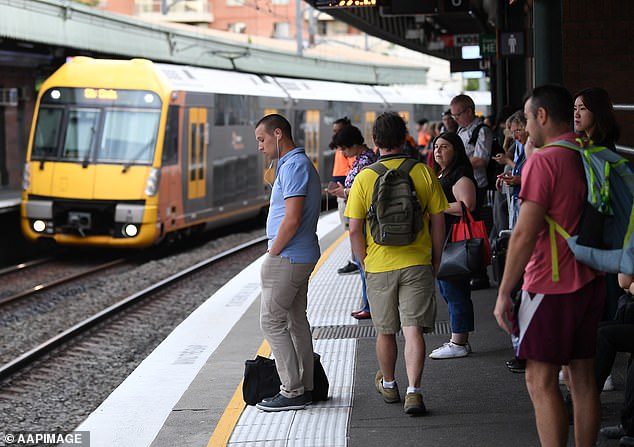A major dispute between Sydney Railways and the New South Wales government has calmed hours before a major strike threatened to paralyze the network.
New South Wales Premier Chris Minns said the government had agreed to operate as many 24-hour train services as possible this weekend from Thursday night to avoid the strike.
“Intensive negotiations will begin over the next two weeks between the government and the New South Wales unions with a view to all parties reaching a long-term agreement between the unions that cover the railways in the state and that will last several years” , said.
The Railway, Tram and Bus Union (RTBU) previously said the strike would take place from Friday morning until mid-morning Sunday. It was expected to be one of the largest railway strikes the city has ever seen.
There are a number of major events in Sydney this weekend, including a Pearl Jam concert and six A-League doubleheaders, and major delays and congestion were expected.
Around 700,000 people take a train in Sydney each day, so more than a million commuters would have been affected if Sydney trains had stopped running for more than 48 hours.
Transport for NSW said Sydney’s intercity rail network would also be affected “over the weekend, due to protected industrial action”.
‘At this time, the bans notified by the union will result in the closure of the heavy rail network on Friday, Saturday and until Sunday morning.
“This will affect passengers, including those traveling to and from Newcastle, the Central Coast, the Blue Mountains, the Southern Highlands and the Illawarra.”
A strike that threatened to paralyze Sydney trains this weekend has been called off.
Could other public transports cover future strikes?
Sydney Metro was not affected by the strikes, but unrelated maintenance work reportedly closed it on Saturday and Sunday.
The NSW Government has said it would put additional services to run every four minutes throughout Friday until 8pm, where it would have changed to eight-minute services until the last train from Central to Tallawong at 1.30am. on Saturday.
Sydney light rail would also have run all weekend, with services running at increased frequency between 7am and 7pm on Saturday, similar to the schedule on Friday.
Additional buses would also be brought in to ease the load across the network.
Before it was called off entirely, the strike had already been pushed back from Thursday to allow 40,000 Pearl Jam fans to return home that night.
But ticket data showed many of those attending Saturday’s Pearl Jam concert live on the Central Coast and in Newcastle.
“We are asking those people to pay attention to ongoing news updates in terms of where transport will be provided and make alternative arrangements… we still cannot rely on having a clear path to Sydney Olympic Park or home again”. if you’re coming from outside Sydney,’ transport bosses warned.
‘Parking at the Olympic Park is almost sold out and the department is looking for more parking space around the stadium.
“Our operators will struggle to fill those gaps…we’re really asking for patience.”

The light rail network was not going to be affected by the strike and would have continued operating

The strike would have affected more than a million travelers causing significant congestion.
What are the union’s demands?
The RBTU, which represents train drivers as well as cleaners, CCTV operators and technicians across the railway network, is demanding better pay and working conditions.
They want a 32 percent pay increase over four years.
They also want training allowances, an additional 1 per cent employer pension contribution and for super to continue to be paid during extended leave, such as maternity leave or workers’ compensation.
The RBTU also wants more flexible working conditions, including a 35-hour work week with no pay reduction and better overtime rates.
It also wants annual leave to increase from four to five weeks for non-shift workers and to six weeks for shift workers.

The light rail network, along with buses, ferries and the subway, would have covered some of the closure, but delays would have remained a major problem.
How did the negotiations fall apart?
NSW Transport Minister Jo Heylan said there have been more than 50 bargaining meetings between the NSW government and the union, including 28 attended by more than 90 delegates.
“I think there is a package on the table that the union can consider,” he said.
‘The only way to keep our network running and ensure people can get where they need to is for the union to call off their strikes. …that remains our request to the unions.
‘This will cause significant disruption to people’s lives and the functioning of our city.
“You can’t just click your fingers and change the way a very large system works.”
RBTU NSW secretary Toby Warnes said: “The reason we will not be lifting the bans at this stage is ongoing frustration with the government for not coming to the negotiating table.”
The union had given the government an ultimatum to operate all railway lines 24 hours a day, from Thursday to Sunday, or face a total closure.
The government agreed to a 24-hour trial last weekend, but said it would not be possible this week. Instead, it had proposed offering a 24-hour service between Hornsby and Strathfield.
“Rest assured our teams are doing everything they can to keep the system running reliably,” Sydney Trains chief executive Matt Longland said.
“It is a very challenging period as more and more industrial bans of this type are imposed.”
The compromise deal came as the government agreed to operate as many 24-hour train services as possible this weekend from Thursday night.


